![]()
![]()
![]()
Use LEFT and RIGHT arrow keys to navigate between flashcards;
Use UP and DOWN arrow keys to flip the card;
H to show hint;
A reads text to speech;
86 Cards in this Set
- Front
- Back
- 3rd side (hint)
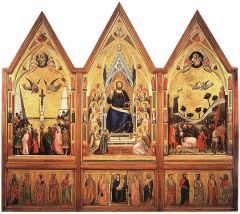
|
"Stefaneschi Triptych Altar Piece"
Artist: Giotto Date: 1306-1307 Original Location: St. Peter’s Basilica, high altar Current Location: the Vatican Style: Gothic |
Why is it important?
Commissioned by Cardinal Giacomo Stefaneschi Depicts how the size of a figure determines its importance. Isocephalic – having all the heads of the figures at the same level, typical of Medieval style. Right side shows Peter being hung upside down. Center shows Christ the king (bigger than everyone else). Left side shows Paul being beheaded. Center panels depict the perfect world. Side panels depict the natural world. Leaning towards Renaissance, or the focus on the real world |
|
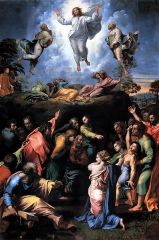
|
"The Transfiguration of Christ"
Artist: Raphael Date: 1517 Current Location: the Vatican Style: High Renaissance |
Why is it important?
Commissioned by Cardinal Giulio de Medici, later Pope Clement VII. The painting is propagandistic, meant to depict that Christ was divine on earth no matter what Luther says. Apostles below trying to perform a miracle. Two men on the left show vintage Da Vinci qualities. Small muscular boy in front show classic Michelangelo traits. Raphael is inventive through combining messages to tell a story. Raphael shows order by structuring his art for the eye. Raphael depicts richness and beauty through the tactile and “perfect” quality. All key characteristics of Raphael and high renaissance art. |
|

|
The Apoxyomenos, or “The Scraper”
Artist: Lysippus Date: 1st century A.D. recreation of 4th century B.C. statue Current Location: the Vatican Style: Renaissance, classical sculpture |
Originally in bronze, this is the recreation.
Classic in nudity, monumental, size. Looks similar to the David. Artist is searching for perfection. Canon of proportions. |
|

|
"Laocoön and His Sons"
Artist: three Greek sculptors Date: 1st century B.C. Original Location: Ancient Greece Current Location: the Vatican Style: |
Attributed by Pliny the Elder.
Message: no matter who you are, you can’t defeat the gods. Michelangelo helped find the statue. |
|

|
Stanza della Segnature
Artist: Raphael Date: 1508 - 1511 Original Location: personal library of Julius II Current Location: the Vatican Style: Renaissance |
Where all the papal edicts were signed.
Julius II was known as “Terribilità,” which means spirited, terrible, irascible, unwilling to bow to anyone’s genius but own. Walls represent poetry, religion/theology, law, philosophy – the four bodies of knowledge. Sense of grace and effortlessness in Raphael’s art. |
|
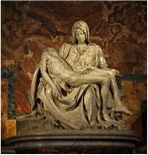
|
"Pietá"
Artist: Michelangelo Date: 1498 Original Location: Old. St. Peter’s Basilica Current Location: St. Peter’s Basilica Style: Renaissance |
Commissioned by a French cardinal.
Altar piece dedicated to the Virgin Mary. Became Michelangelo’s calling card. His only signed piece. Dead Christ on his mother’s lap. Visual image of “transformation” – bread, blood, body of Christ. Mary = church, Christ = salvation. |
|
|
1929
|
Lateran Accord between Mussolini and Pius XI in Vatican City
|
|
|
|
Reigned 1503-1520
|
Pope Julius II
|
Heralded High Renaissance Style
|
|
|
1305-1419
|
Great Schism
|
1409-1417 With multiple popes
|
|
|
2 Fronts for Vatican Reformation
|
New Jerusalem (moral and spiritual center, Hebrew) and New Athens (cultural center, Greco-Roman)
|
Unified, centered power
|
|
|
1473-1483
|
Construction Period for Vatican City
Length - 2x Height and 3x Width |
Emulates Temple of Solomon/Temple of Kings in Jerusalem
|
|
|
Conclave
|
Where Popes are elected in the Sistine Chapel
|
|
|
|
Apostolic Succession
|
Trace lineage of Peter to Present Pope
|
Spiritual Leader and Prince of the Church, Rock upon which we place our foundation
|
|

Sistine Chapel - North Wall
|
Scenes of the life and times of Jesus, the Christ (anointed). Such as "The Sermon on the Mount" by Rosselli and "The Baptism of Jesus" by Perugino.
|
Age of Grace
|
|

Sistine Chapel - North Wall
|
Frescoes in between windows: Pre-Constantinian sainted popes
|
|
|

Sistine Chapel - South Wall
|
The stories behind Moses, such as "The Ten Commandments" by Rosselli and "Moses’ Journey through Egypt" by Perugino.
|
Age of Law
|
|

Sistine Chapel Ceiling
|
9 Scenes from Genesis (R to L):
1-3: Creation of Matter by God 4-6: Creation of Man 7-9: Story of Noah |
|
|

Sistine Chapel - Ceiling
|
Spandrels and Lunettes: Ancestors of Christ
|
List of names that begins with the Gospel of Matthew, the generations linking Christ with the tribe of David.
|
|

Sistine Chapel - Ceiling
|
Quattrocento frescoes: Hebrew Prophets and pagan Sibyls who foresaw the coming of the Messiah
|
|
|

Sistine Chapel - Ceiling
|
Double Corner Spandrels (Pendentives): Scenes of Old Testament Salvation -
Entrance (Tyrannicides): 1. David killing Goliath 2. Judith and Holofernes Other end: 3. The Death of Haman 4. Moses and the Serpent of Brass |
|
|

Sistine Chapel - Ceiling
|
Entrance: Prophet Zachariah - prophesied Christ as branch/tree and symbolic entry into Jerusalem
Other end: Prophet Jonah - belly of the fish - symbolizing Christ's burial and resurrection |
|
|
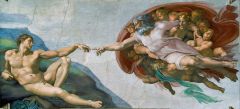
|
Creation of Adam
Sistine Chapel |
Much more painterly, than sculpturally. Physical to spiritual movement. Heavy emphasis on figural form. Perfection. Man is living, breathing image of God.
Adam, first Christ. Eve, First Mary. |
|
|
Animas
|
Soul, life, animation - God
Creation of Adam in Sistine Chapel |
Difference in life and animation between Adam and God in The Sistine Chapel, "Creation of Adam"
|
|
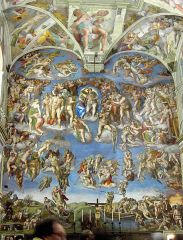
Sistine Chapel - East Wall
|
"The Last Judgement"
c. 1535-1541 After the Sack of Rome. Depicts the second coming of Christ and the Apocalypse. |
|
|
|
Buon (True) Fresco
|
Watercolor painted onto newly applied, damp plaster.
|
Michelangelo transferred his designs for the Sistine Chapel to the wet plaster by holding it up and following the lines with a stylus, making grooves that can still be seen.
|
|
|
A Secco Fresco
|
Watercolor painted onto dry plaster
|
Michelangelo used this technique to retouch the Sistine Chapel ceiling after it's completion.
|
|
|
Ignudi
|
The nudes, in Italian. Ideal restorations of the famous "Belvedere Torso". The physical ideal used as a vehicle for artistic expression that gave way in his old age to a spiritual one.
|
Characteristic of Michelangelo's art; his most personal and revealing contribution to the ceiling
|
|
|
Sistine Chapel
|
Artist: Michelangelo
Date: 1508-1512 Location: Vatican City |
THEME: Redemption
Completed in Thirds: payments, scaffolding, painting. |
|
|
Michelangelo's assistants for Sistine Chapel
|
Perugino
Signorelli Botticello |
|
|
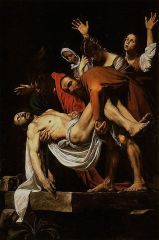
|
"The Entombment of Christ"
Artist: Caravaggio Date: 1602-1603 Current Location: the Vatican Style: Late Renaissance (borderline Baroque) |
Why is it important?
Most important artist to embody shift from Renaissance to Baroque. Connects with the viewer formally and emotionally. The ambiguity of the narrative creates multiple narratives. |
|
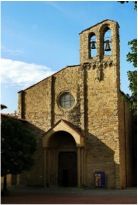
|
Church of San Domenico
Location: Arezzo Date: early 1200s Style: Pre-Renaissance |
One of the most important Pre-Renaissance churches in Arezzo.
New ideas for Christian Reform: 1. Public Preaching 2. Direct/complete devotion to Christ 3. Rise of Secularism - stories now accessible Education - teaching in a scholastic way, the role of the Dominican Order |
|
|
Greccio
|
Manger Scene
Created by St. Francis |
|
|
|
Horror Vacui
|
The filling of the entire surface of a space or an artwork with detail.
Also Cenophobia - fear of open spaces |
|
|
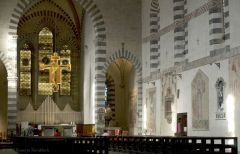
|
Colors of stripes on arches representative of Dominican habits.
White - purity Green - hope Red - faith B&W - Islamic Aesthetic |
Dominican habits
|
|
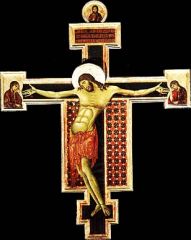
|
"The Crucifixion"
Artist: Cimabue Date: 1265-1270 Original Location: Santa Croce Current Location: San Domenico, Arezzo Style: Late Gothic, early Renaissance |
Early renaissance artist, a generation before Giotto.
One of the first paintings of the dead Christ. Gothic style – emphasis on gold surface pattern. Typical form, stylized crucifix, nodules at end of cross. Geometric qualities of musculature as opposed to naturalistic. Doesn’t look like a body, but evokes a body. Nimbus, or halo Sense of patient suffering - John and Mary suffer in the same way. Emphasis on depicting the figures outside of our world. Emphasizes the new style to come. Tilt of the hips evokes agony - looks like he is in pain even though his eyes are closed. |
|
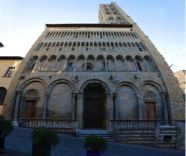
|
La Pieve di Santa Maria Assunta (Santa Maria della Pieve)
Date: 11th Century Location: Arezzo Style: Gothic with Romanesque bell tower |
Dedicated to the assumed virgin Mary. Baptismal church. Part of a Cathedral complex. Lombard architecture, style from the North. Huge columns, but each column is different - emphasis on variety. Organic approach, almost has a painted quality.
Classically inspired: 1. Capitals: Corinthian 2. Columns: monolithic - Probably original Roman arches 3. Tympanum – the semi-circular or triangular decorative wall surface over an entrance, bounded by a lintel and arch; assumed virgin Mary ascending to heaven with angels’ help. Secular scenes on each side that represent the seasons: Winter - pig, Fall: grape, Summer: wheat. Romanesque in inside: formal, columns, arches, Basilica format, small windows. Entire church restructured in 1890s. Patron saint and bishop of Arezzo, San Danato, a martyr, head is found in Pieve crypts. Primary, Secondary, Tertiary relics as physical evidence of the presence of God. |
|
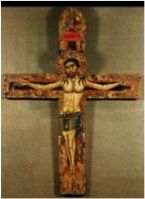
|
"Crucifixion"
Artist: Margaritone d’Arezzo Date: 1230s Location: Pieve, Arezzo Style: Gothic |
Poised posture, delicate, not naturalistic. Pain is not a factor, eyes open.Very stylized, standard folds of fabric, almost cartoonish
Iconic image of god, victorious over death. God, not man. |
|
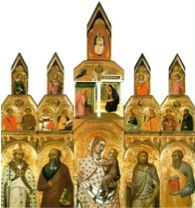
|
"Madonna and Child with Saints"
Artist: Pietro Lorenzetti Date: 1320 Location: Pieve, Arezzo Style: Gothic |
Paid for by Guido Tarlotti, the future arch bishop, and by
donation, people on their deathbeds donated for forgiveness of their sins. Isocephalic - heads on same level. Saints depicted (left to right): San Donato, St. John the Evangelist, St. John the Baptist, and St. Matthew. Painted on wood with gold leafing. Gothic style through use of modeling, tactile quality. Move towards Renaissance through sense of connectivity between Madonna and child. It’s removed from reality, no narrative. |
|
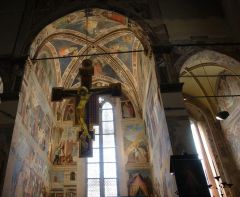
|
"The Finding and Proving of the True Cross"
Artist: Piero della Francesco Date: 1462 Location: Bacci Chapel, Basilica of San Francesco, Arezzo Style: |
Continuous narrative based on “The Golden Legend” by Jacopo da Voragine, Archbishop of Genoa, 1266
|
|
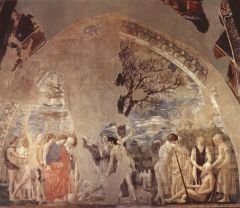
"The Finding and Proving of the True Cross"
|
1. Death of Adam, Seth meeting the Archangel Michael
|
1. Adam tells story of forbidden fruit and sends his son, Seth, back to the garden to ask for the oil of mercy.
2. Archangel tells Seth to plant the branch from the tree on his father’s grave. 3. Lamenting the death of Adam. |
|

"The Finding and Proving of the True Cross"
|
2. The Adoration of the Holy Wood; the Queen of Sheba kneels in front of the wood from which the cross will be made and meets King Solomon
|
1. Sheba spoken to by log, “upon this log a true king greater than Solomon shall perish”.
2. Sheba describes the voice to Solomon and he instructs his servants to throw the log out. |
|
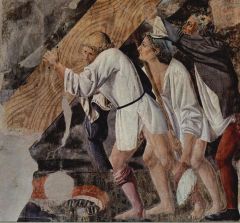
"The Finding and Proving of the True Cross"
|
3. The burial of the Sacred Wood
|
|
|
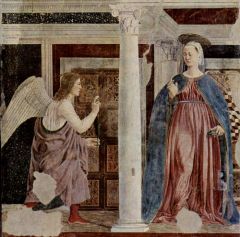
"The Finding and Proving of the True Cross"
|
4. The Annunciation to Mary
Time jump to year 0 |
Time Jump
|
|
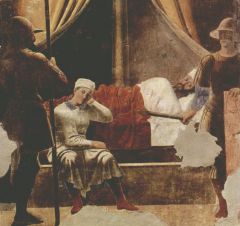
"The Finding and Proving of the True Cross"
|
5. The Vision of Constantine
Time jump to year 315 |
First successful attempt at a night scene.
Constantine hears the angel speak to him, so he wakes and paints crosses on shields – ends up winning the battle. Organization of scene important – fervent angel pierces the otherwise flat, serene picture, narrative comes to life, calm night juxtaposed by angel. |
|
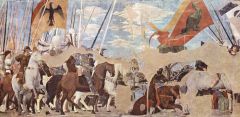
"The Finding and Proving of the True Cross"
|
6. The Victory of Constantine (Constantine's victory over Maxentius at the battle of Milvian Bridge)
|
Battle won by miracle, without bloodshed, simply by Constantine holding out cross.
|
|
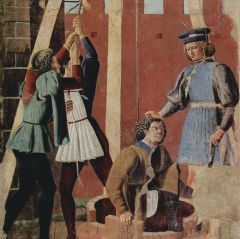
"The Finding and Proving of the True Cross"
|
7. The Torture of Judas the Jew
|
St. Helena tortures Judas for location.
|
|
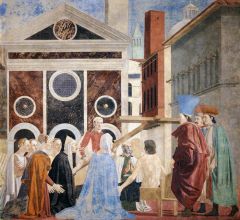
"The Finding and Proving of the True Cross"
|
8. The Discovery and Proof of the True Cross
|
Holding the three crosses over the dead man to test which is the true cross; the third cross raises him from dead
|
|

"The Finding and Proving of the True Cross"
|
9. The Battle of Heraclius and Chosroes
528 A.D. |
Fight over the true cross; Croseros has stolen it and profaned it by setting himself up as God the Father which upsets Heraclitus who goes to Persia to reclaim it – this battle is won through vigor of man.
|
|
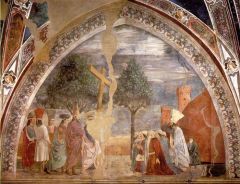
"The Finding and Proving of the True Cross"
|
10. The Exaltation of the Cross
|
Heraclitus presents the cross to Jerusalem through two narratives:
1. Not allowed in at first because of his prideful entry. 2. He is allowed in second time through humility. |
|
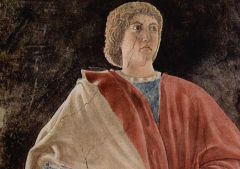
"The Finding and Proving of the True Cross"
|
11. The Prophet Jeremiah
|
|
|
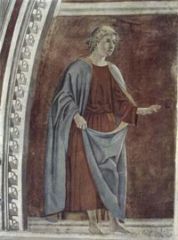
"The Finding and Proving of the True Cross"
|
12. The Prophet Ezekiel
|
|
|
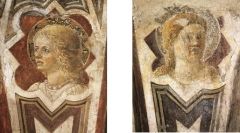
"The Finding and Proving of the True Cross"
|
13. An Angel
|
Cupid
|
|
|
1453
|
Constantinople Falls
|
Battle scenes depict the world of the militant Franciscan.
Eastern influence of the time – ideas, texts, fashion. War is in the air through the 1450s. “Saving the Holy Land”: Franciscan priest jumps in a suit of armor and joins the fight in 1456; Shows the militant nature of Franciscans. |
|
|
Etruscans
|
An early Roman civilization. Invented the grid system. Learned how to “found” and inhabit land.
Built the actual town on the hill. |
|
|
|
4th century B.C.
|
Romans take over Firenze and 11 other city-states.
|
|
|
|
Castrum
|
Fortified village
|
|
|
|
Cardo
|
North-South Axis/streets
|
Firenze, grid-system
|
|
|
Decumanus
|
East-West Axis/streets
|
Firenze, grid-system
|
|
|
The Forum (def'n)
|
Intersection of the Decumanus and Cardo.
|
Central point of commerce and philosophy in town.
|
|
|
Fall of Rome
|
5th century.
Begins to expand in the 11th century, booming by the 12th century, mercantile empire by the 13th century. |
|
|
|
Renaissance (Def'n)
|
"Rebirth"
Of Ancient Rome |
|
|
|
Qualities of the Renaissance
|
1. Importance of Classical Rome
2. Importance of the Individual 3. Importance of a Common Language/Vernacular - Italian |
|
|
|
Uffizi
|
"Offices"
Built by Giorgio Vasari from 1565-1570, who was considered the first art historian. Used to be connected to the town hall. |
Wrote "The Lives of the Various Illustrious Artists," which is responsible for how we understand the progression of the Tuscan Renaissance. Viewpoint = anything after the 3 Greats are just wannabes.
|
|
|
The 3 Greats
|
Michelangelo
Rafael Leonardo |
Donatello was later, the 4th, but runner up for title "Great"
|
|
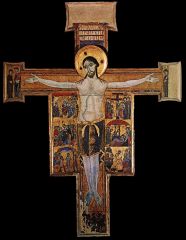
|
"Christus Triumphans"
Location: Galleria degli Uffizi Date: 12th Century Christ is shown alive on the cross to denote that he has triumphed over death. |
Transition from Middle Ages to Renaissance:
Phase 1: Christus Triumphans, triumphant Christ on Cross Phase 2: Emphasis on Christ as man, but still extra worldly (^Greek style) Phase 3: Heirarchy of size, lots of gold, emphasis on invisible (^Gothic style) TRANSITION Phase 4: Giotto goes from “Greek style” to “Latin style” |
|
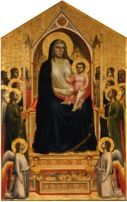
|
"Maestá"
Artist: Giotto Date: 1311 Location: Uffizi Style: late Gothic |
Translates to majesty. Heavy use of modeling to create figure; you can see the body. Creates volume. Christ as the baby is still depicted as manly; he is old before his time. Strong; weight of the world on his shoulders.
|
|
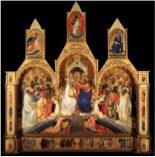
|
"Coronation of the Virgin"
Artist: Lorenzo di Monaco Date: 1414 Original Location: Santo Trinita Current Location: Uffizi Style: Pre-Renaissance |
Commissioned by the Strocci family for a traditional style. Coronation: the end of events. Dormition: sacred slumber. Mary is not dead; she is indeed
immaculate. Saints depicted became martyrs; stood for humanity and bloodshed for Christ. Martyrdom based on “the Golden Legend” by Jakopov Voragine in 1266. The lives of the saints: 1. St. Stephen with stones on his head 2. St. Peter holds a key 3. St. John the Baptist wears a hair shirt and holds a staff 4. St. Lawrence holding the grill iron (and palm frond sometimes) 5. Angels - Wings aren’t supposed to look real; they are unreal, surreal. |
|
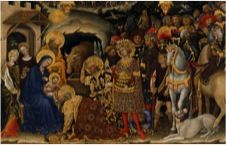
|
"Adoration of the Magi"
Artist: Gentile da Fabriano Date: 1423 Location: Uffizi Style: Renaissance |
Commissioned by Strocci family (bankers).
Depicts a CONTINUOUS NARRATIVE, or the same figures repeated in a single scene. 1. Top: sees star, travels to Jerusalem, travels to Bethlehem. 2. Foreground: main painting – visits baby Jesus. Combination of the religious and the secular; staple in Renaissance art. 3. Emphasis on physical detail/material possession in foreground right. 4. Transitions to spiritual depiction in foreground left. 5. Foreshortening: seeing something 2D in a 3D way with servant bent over towards viewer. Emphasis on the individual and physical detail. CAUSE AND EFFECT: kings bowing and baby Jesus pats their head, Madonna catching baby while covering herself, foot reflex as king kisses baby Jesus’ feet – all very natural responses. |
|
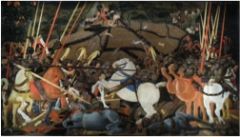
|
"Battle of San Romano"
Artist: Paolo Ucello Date: 1440 Original Location: Bedroom of Lorenzo de Melacino Current Location: Uffizi Style: Renaissance |
Was hung 10 feet up, so the viewing is skewed because it is based on perspective.
Part of 3 battle scenes. *Called the first scientific style of the renaissance. First to really explore the visible world. |
|
|
One-Point Linear Perspective
|
The use of a single vanishing point
with the combination of horizontal and vertical lines (orthogonal and transversals) which recede into background at vanishing point. |
|
|
|
Alberti
|
Leon Baptista Alberti, published the “Treatise of Terms” in 1435 in Latin, in 1436 in Italian. Combined math and art in the study of optics.
|
|
|
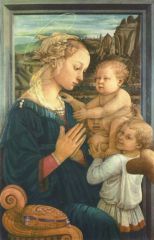
|
"Madonna with Child and Two Angels"
Artist: Fillipo Lippi Date:1465 Location: Uffizi Style: Renaissance |
Mary looks naturalistic; Christ looks more childlike. Softer light with no visible light source. The landscape is Tuscan. Real time rather than eternity. Importance of engagement between audience and viewer; no longer about the scholastic approach; more emotional.
|
|
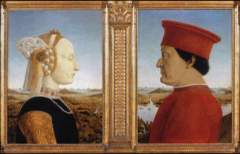
|
"Duke and Duchess of Urbino"
Artist: Piero della Francesca Date: 1472-1475 Original Location: Duke of Urbino’s studio Current Location: Uffizi Style: Renaissance |
Duke creates the town and earns all of his money by being
a “condottieri,” or mercenary. He is the most important mercenary of the 15th century. His profile depicts ancient Roman coinage. Emphasis on man and his essence. Captures him as an individual, rather than a “perfect” beauty. Duchess is not that identifiable, looks like a typical woman with no definable features. |
|

|
"Birth of Venus"
Artist: Botticelli Date: 1484 Original Location: temporary canvas, for wedding Current Location: Uffizi Style: Renaissance |
Introduces a new aspect of Renaissance; emphasis
on education, importance of intellect. Neo-platonic tradition; a new emphasis on Plato and Aristotle. Duality of two worlds – the perfect world and the imperfect world. 1. Right side: world of man represented by “time,” 2. Left side: world of the gods represented by the god of wind, 3. Middle: Venus, the embodiment of beauty. |
|
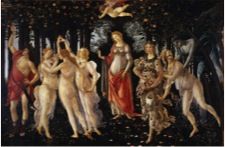
|
"Primavera"
Artist: Botticelli Date: 1480s Original Location: outside nuptial chamber, for wedding Current Location: Uffizi Style: Renaissance |
Oil painting on panel, not meant to be seen.
Otherworldly; depicts the seasons: March: Zephyr, god of wind April: Clora, Zephyr’s concubine May: Flora Mercury on left Venus in center: bride to be |
|
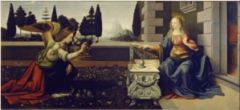
|
"Annunciation"
Artist: Leonardo da Vinci Date: 1473 Current Location: Uffizi Style: Renaissance |
Early Da Vinci. Imperfections.
Emphasis on the natural world. ATMOSPHERIC PERSPECTIVE – sky lightens as it distances from foreground. 1. Foreground: very depicted colors and true lines 2. Midground: turns green with less defined lines 3. Background: emphasis on blue and has a misty quality One-point perspective ends in the center of the painting. Da Vinci’s only attempt at one-point-linear perspective. |
|
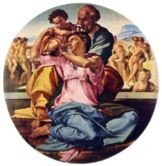
|
"Doni Tondo"
Artist: Michelangelo Date: 1507 Original Location: gift for new mother Current Location: Uffizi Style: Renaissance |
Only panel painting by Michelangelo.
The date is a “mystery” however, as well as the story of the pigment Foreground: Mary, Joseph, and Jesus; holy family. Mid ground: John the Baptist and nudes. Background: landscape and atmospheric perspective. |
|
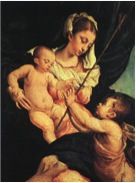
|
"Madonna and Child and John the Baptist"
Artist: Jacopo Bassano Date: 1570 Current Location: Uffizi Style: Renaissance |
|
|
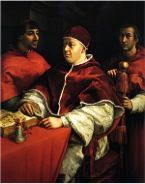
|
Leo X
Artist: Rafael Date: 1518 Current Location: Uffizi Style: Renaissance |
Show’s Raphael’s true artistry.
First Medici pope. Seems dislocated with reality; three figures who don’t seem to be communicating. Symbolizes Roman disconnect. Raphael seems to know things are awkward and will eventually change. Beauty of Raphael is in his portraiture. |
|
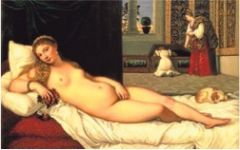
|
"Venus of Urbino"
Artist: Titian Date: 1538 Original Location: Studio, covered up Current Location: Uffizi Style: Renaissance |
Commissioned by the great-grandson of the Duke of Urbino, Guidobaldo II della Rovere.
Used to be known as "The Courtesan" Epitome of a man’s perspective of beauty in the 16th century. Sfumato: smoky, Da Vinci-esque; o Dainty feet o Smaller breasts o Reddened knees o Thighs larger o Womb in center of painting − Depiction of wealth: o Country view means a second home o Wedding chests - "cassone" o Maids o Dog - fidelity o Tapestries |
|
|
Characteristics of Medieval Quarter in Firenze
|
1. No Grid System
2. Tight nooks and crannies 3. No street signs 4. Citizens did not venture out farther than 50km from city walls, except merchants |
"Monty Python and the Quest for the Holy Grail"
|
|
|
Factions of Firenze
|
Guelfs vs. Ghibellines
1266 - Guelfs win. Battle destroyed city. Town hall bell tower only remaining original tower. |
Merchant class/Pope vs. Aristocracy/Holy Roman Emperor
In Battle, "Oh, Geez!" |
|
|
Firenze Real Estate
|
High-end.
Streets used to be covered with scaffolding, networking buildings together, easier than walking down, crossing the street and hiking back up. Anything still with bridges today is abandoned to avoid property taxes. Sewers not installed until 1950s. |
Tax Evasion.
|
|

|
Piazza del Limbo/Santi Apostoli in Firenze.
Symbolizes the light in the dark, "everlasting life." Death prevalent with high mortality rates. Inspires transformation: infant cemetery; unbaptized infants in limbo and unrecorded in town hall records. Only Bishops could baptize. Women came to pray 3 times a day. |
Average Age: 45
50% infant mortality 40% men dead by 25 25% women dead in childbirth |
|
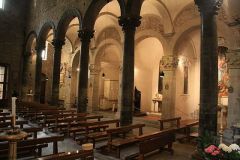
|
Santi Apostoli in Firenze.
Built by Brunelleschi in 11th century (similar to Pieve in Arezzo) Romanesque style: 1. Less natural light 2. Fewer windows 3. Basilica shape 4. Roman Columns and Arches reinvented, like the Coliseum. 5. Odd number of openings: Poor Man's Bible, visualization tool for the illiterate, pop-up book, reminding people to pray. |
Believed to built by Charlemagne even though it dates to the 11th century.
Classical Revival |
|
|
800 A.D.
|
Crowning of Charlemagne in St. Peter's Basilica on Christmas Day, First Holy Roman Emperor.
|
|

